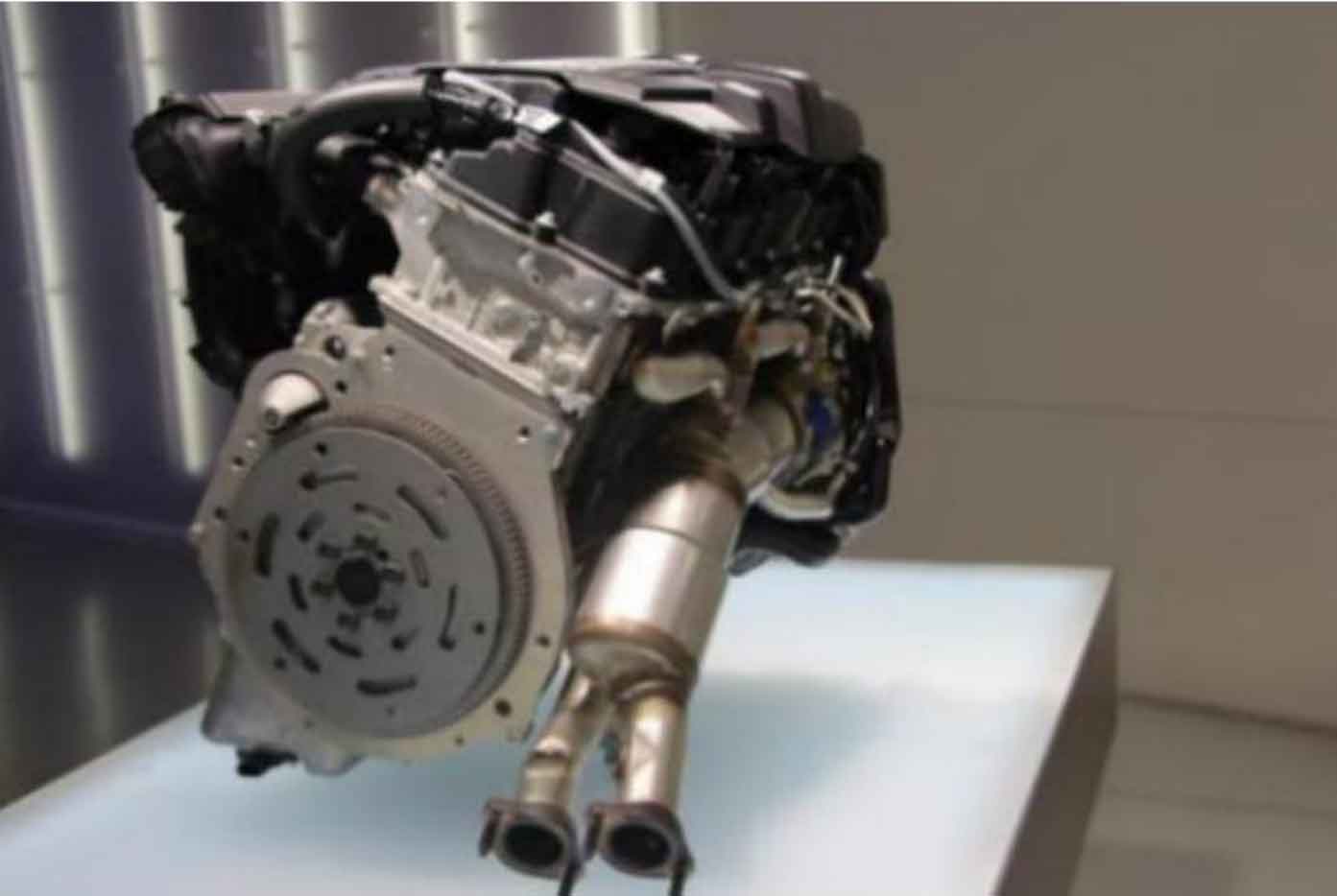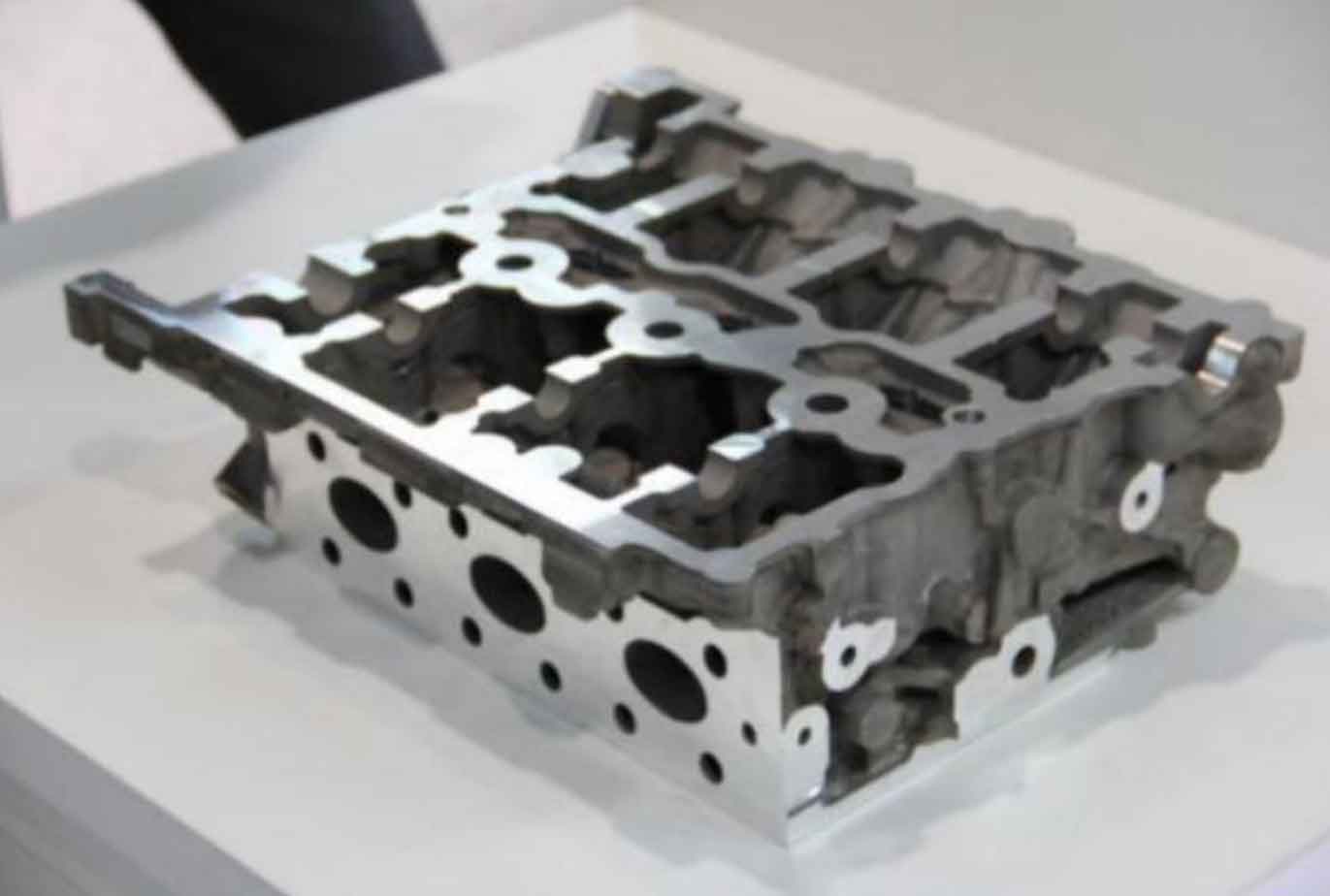Introduction
1. Lost foam casting process
The lost foam casting process is simple, without complex processes such as core making, core baking, demoulding, mold repair and box closing, and direct pouring without mold lifting. The lost foam casting process is divided into three areas: white area, yellow area and black area. The white area is foam molding and casting structure production. The yellow area is to spray refractory paint and dry it until there is no moisture. The black area is filled with sand particles and vibrated and compacted, the molten metal is poured, the castings are cleaned and subsequent heat treatment, and the old sand and waste are recovered.
2. Characteristics of lost foam casting
Lost foam casting is a new casting method which retains the advantages of three casting methods: F method, m method and V method, overcomes the disadvantages of these methods, and realizes the casting technology of high efficiency, high quality, low cost and green environmental protection.
Compared with traditional casting, the advantages are as follows:
(1) Simple and less process, short production cycle and high efficiency;
(2) The labor intensity of workers is low, which improves the working environment;
(3) The dimensional accuracy of castings is high, and the relevant dimensions and tolerances of lost foam casting workpieces.
(4) The degree of freedom of part structure design is increased;
(5) Good casting quality and low scrap rate;
(6) The riser is easy to place and saves the utilization rate of molten metal;
(7) Easy to master process technology and convenient production management;
(8) Less investment and quick results.
3. Application scope of lost foam casting Technology
Each method has corresponding application scope, and lost foam casting process is no exception. The following is the application scope of lost foam casting Technology:
(1) Alloy type: all metals that can be used for sand casting are suitable for lost foam casting process. The poured alloys include black alloys such as ordinary cast steel, stainless steel, alloy cast iron and nodular cast iron, as well as non-ferrous alloys such as aluminum, magnesium and copper.
(2) Casting size: in short, the size of the sand box determines the size of the lost foam casting, that is, the size of the sand box is as large as the casting. The casting weight can range from a few kilograms to hundreds of kilograms. Considering the existing process level and actual operation, the minimum wall thickness of the casting should be greater than 4mm.
(3) Casting structure: it has more advantages for castings with complex structure and difficult pattern parting and modeling. lost foam casting does not need to consider the structural and technological problems such as parting and stripping, and has strong adaptability to the casting structure, especially for castings with difficulties in parting, stripping and core lowering.
At present, the successful castings include: complex automobile engine cylinder block, cylinder head (as shown in Figures 1 and 2), gearbox shell, intake pipe, etc.
Chapter 1: The lost foam casting process
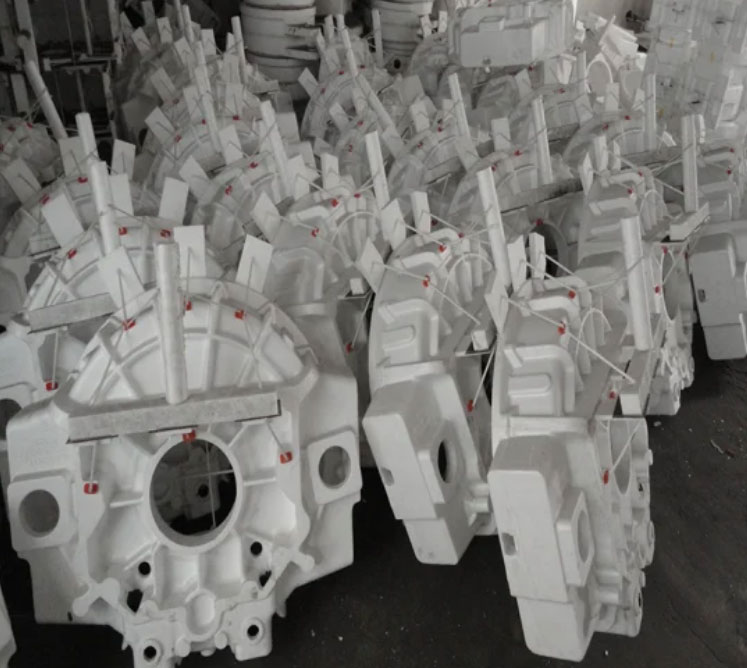
- Pattern Creation: Create a foam pattern of the desired part using expandable polystyrene foam. The foam can be shaped using various methods, such as carving, cutting, or molding. The foam pattern should replicate the final part’s geometry, including its intricate details.
- Pattern Assembly: Assemble multiple foam patterns onto a gating system, which includes channels for the molten metal to flow through. The gating system consists of sprues (main channels), gates (secondary channels), and risers (vents for gas escape). The gating system ensures proper metal flow and filling of the mold.
- Mold Coating: Coat the assembled foam pattern and gating system with a refractory material. This material can be a mixture of fine sand and binders. The refractory coating adheres to the foam pattern, creating a shell that can withstand the heat of the molten metal.
- Pattern Embedding: The coated foam pattern is placed in a flask, and fine sand or other refractory material is packed around it to create a support mold. The flask holds the mold components in place during the casting process.
- Foam Vaporization and Metal Pouring: As the flask is filled with molten metal, the heat of the metal causes the foam pattern to vaporize rapidly. The expanding gases created by the vaporization escape through the refractory coating. The molten metal flows into the cavity created by the vaporized foam pattern, filling the mold completely.
- Solidification and Cooling: The molten metal solidifies within the mold cavity, taking on the shape of the foam pattern. The cooling process allows the metal to achieve the desired metallurgical properties and structural integrity.
- Mold Breakout: Once the metal has cooled and solidified sufficiently, the flask is opened, and the refractory mold is broken away. This reveals the final metal casting, which is still attached to the gating system.
- Gating System Removal: The sprues, gates, and risers are removed from the casting. These parts are usually excess material that was used to facilitate the metal flow. They are separated from the casting, and any remaining refractory material is removed.
- Finishing: Depending on the desired final appearance and dimensions, the casting may undergo additional finishing processes such as grinding, polishing, and cleaning.
- Quality Control: The finished casting is inspected for any defects, irregularities, or imperfections. Any necessary adjustments or corrections are made at this stage.
Chapter 2: Production of Lost Foam Casting Model
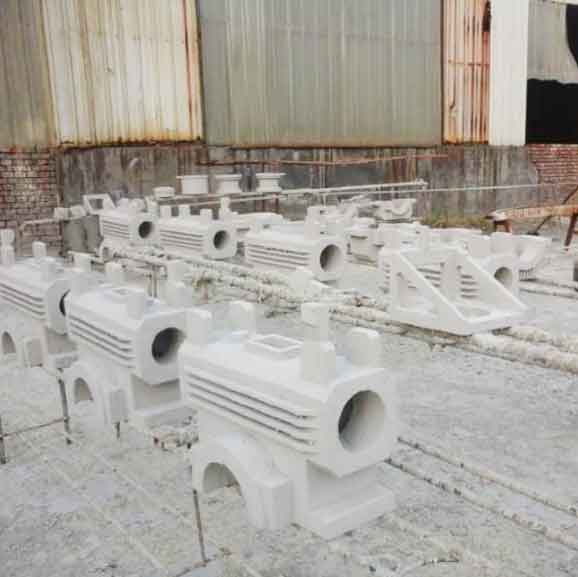
The production of a lost foam casting model involves creating an expandable polystyrene (EPS) foam pattern that will later serve as the template for the final metal part. Here’s a general guide on how to produce a lost foam casting model:
- Design or Select the Model: Determine the design and specifications of the metal part you intend to create. This can involve designing the model using computer-aided design (CAD) software or selecting an existing design.
- Material Selection: Choose the appropriate type of expandable polystyrene (EPS) foam for your model. EPS foam is available in different densities and can be easily shaped and carved.
- Create the Foam Pattern: Use the chosen EPS foam to create the foam pattern that matches the design of the final metal part. This can involve various methods:
- Carving: Carve the foam manually using knives, rasps, and other cutting tools to achieve the desired shape.
- CNC Machining: Use computer numerical control (CNC) machines to precisely shape the foam according to the CAD design.
- Molding: If applicable, create a mold from the foam pattern and use it to produce multiple identical patterns.
- Incorporate Details: Sculpt or carve any intricate details, undercuts, or features into the foam pattern to match the final design requirements.
- Attach Gating System: Attach the gating system, including sprues, gates, and risers, to the foam pattern. These channels allow the molten metal to flow into the mold and ensure proper filling.
- Surface Coating (Optional): Apply a surface coating or sealant to the foam pattern to improve its durability and protect it from moisture and damage during the casting process.
- Quality Control: Inspect the foam pattern for any defects, inconsistencies, or inaccuracies. Make any necessary adjustments to ensure that the pattern accurately represents the desired part.
- Assemble Pattern Cluster (Optional): If your casting requires multiple identical parts, assemble several foam patterns onto a gating system, creating a pattern cluster.
- Pattern Verification: Verify that the foam pattern or pattern cluster is ready for casting, ensuring that all details are accurately represented and that the gating system is properly attached.
- Mold Coating: Coat the foam pattern or pattern cluster with a refractory material. This coating will create the mold when it is heated and the foam vaporizes during casting.
- Prepare the Flask: Place the coated foam pattern or pattern cluster in a flask and pack it with fine sand or other refractory material to create a support mold.
With the completed foam pattern or pattern cluster, you’re ready to proceed with the lost foam casting process. Remember that attention to detail during pattern creation is crucial to ensure accurate replication of the design in the final metal casting.
Chapter 3: Production Steps of Lost Foam Casting
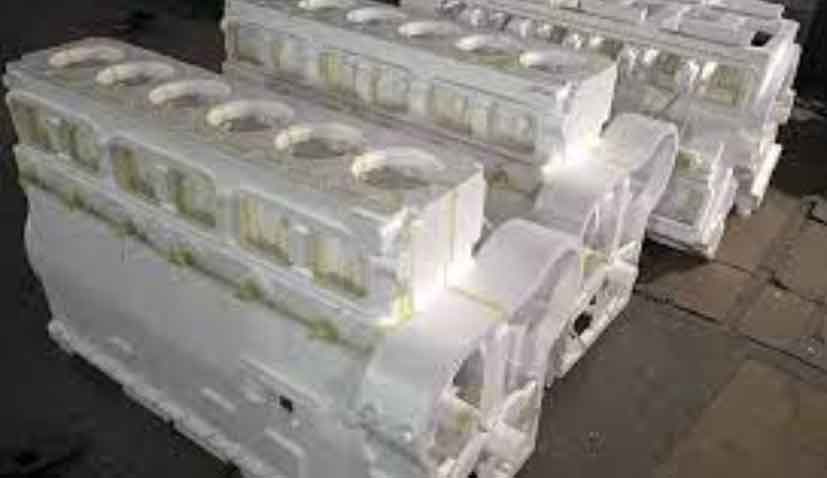
The lost foam casting process involves several key production steps, from pattern creation to the final casting. Here’s a step-by-step overview of the process:
- Pattern Creation: Create an expandable polystyrene (EPS) foam pattern that replicates the shape and details of the desired final metal part. This can involve carving, machining, or molding the foam to achieve the desired geometry.
- Pattern Assembly (Optional): If producing multiple identical parts, assemble several foam patterns onto a gating system, which includes sprues, gates, and risers. The gating system facilitates metal flow and ensures proper filling.
- Pattern Coating: Apply a refractory coating to the foam pattern or pattern cluster. This coating adheres to the foam, creating a shell that will form the mold during casting. The coating should be uniform and provide thermal insulation.
- Flask Preparation: Place the coated foam pattern or pattern cluster into a flask, which is a container that holds the mold components during casting. The flask will also support the refractory material that forms the mold.
- Mold Packing: Pack fine sand or other refractory material around the coated foam pattern to create a support mold. The refractory material should form a solid structure that maintains the shape of the pattern.
- Metal Pouring: Heat the metal alloy to its appropriate pouring temperature. Pour the molten metal into the mold through the gating system. The metal will flow into the cavity left by the vaporized foam pattern.
- Foam Vaporization: The heat of the molten metal causes the foam pattern to vaporize rapidly. The expanding gases generated by the vaporization escape through the refractory coating, leaving behind a cavity in the shape of the pattern.
- Metal Filling: The molten metal flows into the cavity created by the vaporized foam pattern, filling the mold completely. Proper gating design ensures smooth and uniform metal flow.
- Cooling and Solidification: Allow the molten metal to cool and solidify within the mold cavity. The cooling process ensures that the metal takes on the desired shape and metallurgical properties.
- Mold Breakout: Once the metal has solidified and cooled sufficiently, open the flask and break away the refractory mold to reveal the metal casting. This should be done carefully to avoid damaging the casting.
- Gating System Removal: Remove the sprues, gates, and risers from the casting. These parts are usually excess material used to facilitate metal flow and escape of gases.
- Finishing: Depending on the desired final appearance and dimensions, the casting may undergo additional finishing processes such as grinding, polishing, and cleaning.
- Quality Control: Inspect the casting for any defects, irregularities, or imperfections. Verify dimensional accuracy, surface finish, and overall quality.
- Post-Casting Processes (Optional): If required, perform post-casting processes such as heat treatment, machining, surface treatment, or assembly.
- Final Inspection and Packaging: Conduct a final inspection to ensure the casting meets the desired specifications. If the casting passes inspection, it is ready for packaging and distribution.
Lost foam casting requires attention to detail at every stage to achieve accurate and high-quality castings. Proper gating design, refractory material selection, and precise pattern creation are essential for successful outcomes.
Chapter 4: Material Selection for Lost Foam Casting
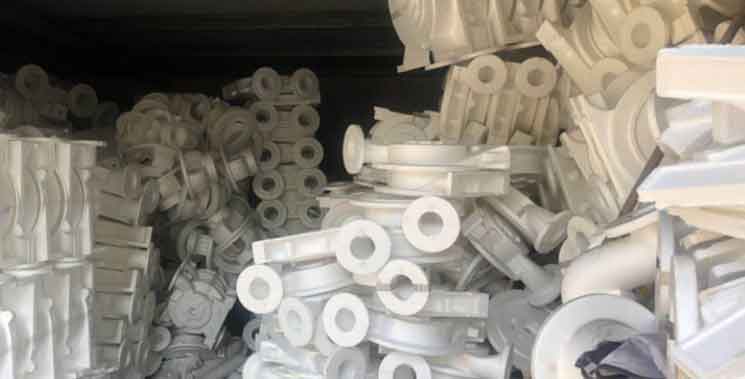
- Foam Pattern Material: The foam pattern serves as the template for the final metal part. It needs to be easy to shape, carve, and replicate intricate details. Common options include:
- Expandable Polystyrene (EPS): EPS foam is widely used in lost foam casting due to its ease of carving, availability in different densities, and ability to vaporize without leaving significant residue.
- Polyurethane Foam: Polyurethane foam patterns are also used and can offer greater detail reproduction and durability compared to EPS foam.
- Refractory Coating Material: The refractory coating is applied to the foam pattern to create the mold. It should provide thermal insulation, resist erosion from molten metal, and allow for the escape of gases during the vaporization of the foam pattern. Common materials include:
- Fine Sand and Binder: A mixture of fine sand and a binder is a traditional choice for creating the refractory coating. The binder helps the sand adhere to the foam pattern.
- Ceramic Slurry: A slurry of ceramic particles and binders can provide a smooth and dense coating that can withstand high temperatures and facilitate gas escape.
- Casting Alloy: The casting alloy determines the mechanical properties, corrosion resistance, and other characteristics of the final metal part. The alloy should be compatible with the casting process and the specific requirements of the part. Common casting alloys include:
- Aluminum Alloys: Aluminum is a popular choice due to its low melting point and good fluidity. It’s suitable for a wide range of applications.
- Iron and Steel Alloys: These alloys require higher pouring temperatures, and the casting process might need to be adapted accordingly.
- Bronze and Brass Alloys: These copper-based alloys are commonly used for artistic and decorative castings.
- Gating and Riser Materials: The gating and riser system facilitates the flow of molten metal into the mold and allows for gas escape. The materials used for gating and risers should withstand the heat of the molten metal and provide proper channels. Common materials include:
- Refractory Coating Extensions: Extending the refractory coating material from the mold onto the gating and riser system can maintain consistency and prevent defects.
Chapter 5: Quality Control of Lost Foam Casting
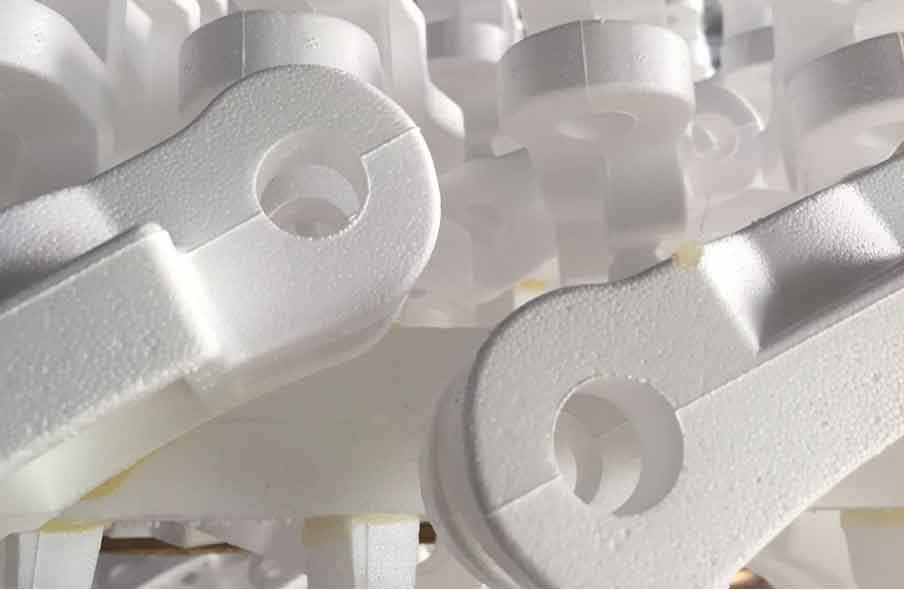
- Pattern Inspection: Before proceeding with the casting process, thoroughly inspect the foam pattern for accuracy, completeness, and any defects. Ensure that all intricate details, undercuts, and features are accurately represented.
- Mold Coating Quality: Check the uniformity and thickness of the refractory coating applied to the foam pattern. Inadequate coating thickness can lead to problems during the casting process.
- Flask and Mold Assembly: Inspect the flask and mold assembly for proper alignment and stability. Improper assembly can result in misshapen castings or defects.
- Metal Quality: Verify the quality of the casting alloy, ensuring that it meets the desired chemical composition, purity, and metallurgical properties.
- Metal Pouring and Filling: Monitor the metal pouring process to ensure uniform and complete filling of the mold cavity. Proper gating design and metal flow control are critical to avoiding defects.
- Cooling and Solidification: Allow the casting to cool and solidify fully according to the recommended time and conditions. Premature removal can lead to structural issues.
- Mold Removal: Carefully remove the refractory mold after the casting has cooled. Check for any signs of mold residue, improper mold breakage, or defects on the casting surface.
- Gating System Removal: Remove the sprues, gates, and risers from the casting. Check for any remaining material, irregularities, or surface defects.
- Dimensional Inspection: Measure the dimensions of the final casting to ensure they match the intended specifications. Pay special attention to critical dimensions, tolerances, and overall geometry.
- Surface Inspection: Inspect the surface finish for any defects such as cracks, porosity, and surface irregularities. These defects can affect the visual appearance and structural integrity of the casting.
- Post-Casting Processes: If applicable, monitor and assess the quality of any post-casting processes, such as machining, polishing, or surface treatment.
- Mechanical Testing: Conduct mechanical tests, such as tensile, hardness, and impact tests, to verify the mechanical properties of the casting. Compare the results with the desired specifications.
- Non-Destructive Testing (NDT): Use non-destructive testing techniques like X-ray, ultrasound, or dye penetrant testing to detect internal defects that might not be visible externally.
- Documentation: Maintain thorough records of the casting process, inspection results, and any corrective actions taken. This documentation helps identify trends and improve future processes.
Chapter 6: Application field of lost foam casting

- Automotive Industry: Lost foam casting is widely employed in the automotive sector for manufacturing engine blocks, cylinder heads, intake manifolds, transmission cases, and other complex components. The process allows for the integration of intricate cooling passages and complex geometries.
- Aerospace and Defense: The aerospace industry utilizes lost foam casting to produce parts such as turbine blades, aircraft engine components, and structural elements. The process enables the creation of lightweight, high-strength parts with precise details.
- Agricultural Machinery: Lost foam casting is used to manufacture parts for agricultural machinery and equipment, including engine components, transmission housings, and structural elements.
- Energy Generation: Components for power generation equipment, such as gas turbines and steam turbines, are often produced using lost foam casting due to its capability to create intricate cooling channels and precise geometries.
- Industrial Machinery: Lost foam casting is utilized to create components for industrial machinery, pumps, valves, gearboxes, and other equipment requiring complex shapes and tight tolerances.
- Medical Equipment: The medical industry benefits from lost foam casting for producing components used in medical equipment such as imaging devices, analytical instruments, and surgical tools.
- Construction and Architecture: Lost foam casting can be used for creating architectural elements, decorative features, and customized hardware for buildings and structures.
- Marine and Shipbuilding: Parts for marine equipment, ship components, and boat fittings can be manufactured using lost foam casting, including propellers, rudders, and navigation systems.
- Railway and Transportation: Lost foam casting is employed in the railway industry for producing components like brake systems, wheel hubs, and structural parts.
- Oil and Gas Industry: Components used in the exploration, extraction, and transportation of oil and gas, such as pumps, valves, and connectors, can be manufactured using lost foam casting.
- Art and Sculpture: Artists and sculptors use lost foam casting to create intricate and detailed metal sculptures and artworks.
- Jewelry and Accessories: Lost foam casting is used in jewelry making to create intricate and artistic pieces, including rings, pendants, and other accessories.
- Entertainment and Film Industry: Lost foam casting is employed to produce props, set decorations, and other metal components used in the entertainment and film industry.
- Research and Development: Lost foam casting is valuable in research and development for creating prototype parts, testing new designs, and evaluating materials.
Lost foam casting’s ability to replicate intricate details, complex geometries, and undercuts makes it suitable for industries requiring precision, performance, and aesthetics. It allows for efficient production of high-quality components while minimizing post-casting machining and finishing.
Chapter 7: The advantages and disadvantages of lost foam casting

Advantages:
- Complex Geometries: Lost foam casting is well-suited for producing parts with intricate shapes, undercuts, and fine details. The foam pattern can be easily carved or molded to achieve complex designs.
- Minimal Draft Angles: Unlike other casting methods that require draft angles for pattern removal, lost foam casting often requires minimal or no draft angles due to the foam’s vaporization.
- Smooth Surface Finish: The surface finish of the foam pattern is transferred to the final casting, resulting in relatively smooth surfaces that may require less post-casting finishing.
- Intricate Details: The process accurately replicates intricate details from the foam pattern to the casting, making it suitable for high-precision parts.
- Material Versatility: Lost foam casting can be used with a wide range of metals and alloys, including ferrous and non-ferrous materials.
- Reduced Tooling Costs: The process can eliminate the need for complex molds, reducing tooling costs compared to other casting methods.
- Design Flexibility: Design changes can be easily accommodated by modifying the foam pattern, making it suitable for prototyping and small-scale production.
- Reduced Waste: The foam pattern is consumed during casting, leaving minimal waste. Any foam trimmings can be recycled for future patterns.
- Less Post-Casting Machining: The precision of lost foam casting often reduces the need for extensive post-casting machining, saving time and resources.
Disadvantages:
- Pattern Creation Complexity: Creating accurate foam patterns requires skilled labor, and mistakes in pattern creation can lead to defects in the final casting.
- Surface Finish Limitations: Intricate surface textures or finishes on the foam pattern might not always transfer perfectly to the final casting.
- Pattern Durability: The foam pattern is fragile and can be easily damaged during handling and assembly.
- Gas-Related Defects: The vaporization of the foam pattern can lead to gas-related defects if not managed properly, resulting in porosity or incomplete filling.
- Size Limitations: Very large castings might be challenging due to the limitations of the investment mold and the casting furnace.
- Pattern Cost: High-precision foam patterns can be expensive to produce due to the expertise and equipment required.
- Production Time: Lost foam casting can take longer due to the creation of foam patterns and the investment casting process.
- Mold Integrity: The refractory mold must withstand the heat and pressure of the molten metal without cracking or deforming.
- Environmental Concerns: The vaporization of foam patterns and the use of refractory materials might have environmental implications.

